The Story Behind Top 10, From the Artists Who Helped Define It
While Watchmen is generally considered to be Alan Moore’s best work, that doesn’t mean it’s everyone’s favorite. Watchmen is undeniably great, an important work in the history of the comic book medium. But people are unique creatures, and our preferences are linked to more than just quality. For some, it might be a superhero universe story, like Batman: The Killing Joke or his time on Swamp Thing. For others, it’s originals like From Hell, V for Vendetta, or The League of Extraordinary Gentlemen. If you suggested one of those was your favorite, odds are, most would understand even if they might prefer another. There isn’t really a wrong answer, per se.
But there are atypical ones.
For example, my favorite Alan Moore project is Top 10, the America’s Best Comics 13 series about the police force of a fictional city called Neopolis. It’s a metropolis filled with superpowered types, and the series follows varying officers and detectives as they contend with the unique challenges that presents. Drawn by the art team of Gene Ha and Zander Cannon with colors by Wildstorm FX and letters by Todd Klein, Top 10 was the first time I’d ever read a comic that existed within the police procedural genre, with a loaded ensemble of cops, criminals, and curiosities. It wasn’t just its complex and appealing core cast that was a draw. Bit players shined in a rare way, to say nothing of the omnipresent Easter eggs the series is famous for. Don’t get me wrong: people liked Top 10. It even won the 2001 Eisner Award for Best Continuing Series. 14 But it always felt overshadowed by its peers in the ABC line, like Gentlemen, Promethea, and Tom Strong.
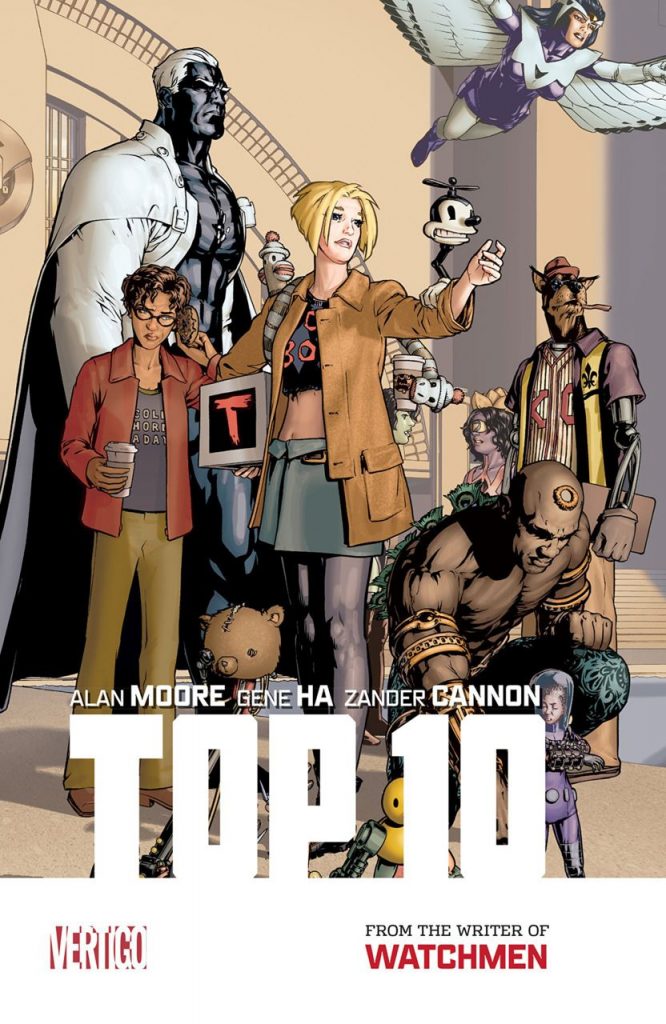
That’s too bad, because its exploration of the Tenth Precinct of Neopolis — the police station nicknamed “Top 10,” where the cast and much of the story is based — and its frequently shifting caseloads is loaded with drama, humor, and astonishingly poignant moments. It’s a riff on the ideas of superhero comics and procedurals, and through characters like Toybox, Smax, Kemlo Caesar, Irma Geddon, and an array of others, we’re given something that is uniquely effective at both of those genres.
Perhaps the thing that makes this story pop most for me is just how unusually in sync the creators involved felt. This isn’t to diminish any of Moore’s other collaborators — needless to say, they’re all brilliant — but there’s just something special about how this team worked. It never felt like individuals executing their roles; instead, it read like a hive mind formed to tell exceptional comic stories, delivering a singular vision like a cartoonist would but as a disparate group of individuals with complementary strengths and weaknesses.
Also: It’s just a hell of an entertaining comic, and one that only gets better with every read.
While Top 10 grew beyond its initial 12-issue story — with Moore and Ha teaming up for Top 10: The Forty-Niners, Moore and Cannon bringing an immediate follow-up in Smax to life, and Ha and Cannon delivering an abbreviated second season for the series, 15 each of which was fantastic — that original volume was just uncommonly great, having a je ne sais quoi to it that made it an extraordinary series. Ever since I read it, I’ve wondered how they accomplished the wonders of Top 10, and what it took to create such a special story. So, recently, I did what I do: I tried to find out.
I sat down with both Ha and Cannon to discuss the story behind Top 10 from their perspective, and how the two worked with Moore to craft this remarkable series. It originally started as a much different piece, one that just found me revisiting an old favorite with insight from two of the folks behind it. Instead, it became a retrospective about a collaboration of a rare quality, the comic that united them, and how certain projects can change everything for you — if you let them.
How the Team Came Together
Gene Ha had been a big fan of Alan Moore for a long time, with his admiration of the legendary writer dating back to high school. By the time he became a pro, working with Moore was a dream. It was also one he was unsure of ever reaching, despite having a connection in his friend and fellow artist Alex Ross, who was drawing covers for Moore’s Supreme at the time. At some point during that run, Ha admitted to his pal how much he wanted to work with the writer himself. That’s when Ross gave him some simple advice that proved to be life-changing.
“(Alex) just said the logical thing of, ‘Well, if you want to, why don’t you go after it?’” Ha told me.
“So, I did.”
The only problem was, by the time Ha started making inroads at Maximum Press — the Rob Liefeld created imprint where Moore was based at the time — the entire house “collapsed.” The artist could have taken that as a sign. Instead, Ha followed Moore over to Wildstorm, contacting the main editor there, Scott Dunbier, to hopefully pass art samples on to Moore. It worked. Moore liked Ha’s art, giving him “the nod as a possible artist” for one of his upcoming titles at America’s Best Comics, the imprint the writer was launching at Wildstorm.
“When I first saw the proposal of, ‘What do you want to do with America’s Best Comics?’ I thought, ‘Wow, I would really like to draw Promethea. And I really hope I don’t get asked to draw Top 10 because it’s all giant city backgrounds and crowd scenes. That’d just break me.’” Ha remembered. “At some point, I got the phone call from Scott saying, ‘Alan would like you on Top 10.’”
“I went, “Not Promethea?’” he added. “But I was going to do it.”
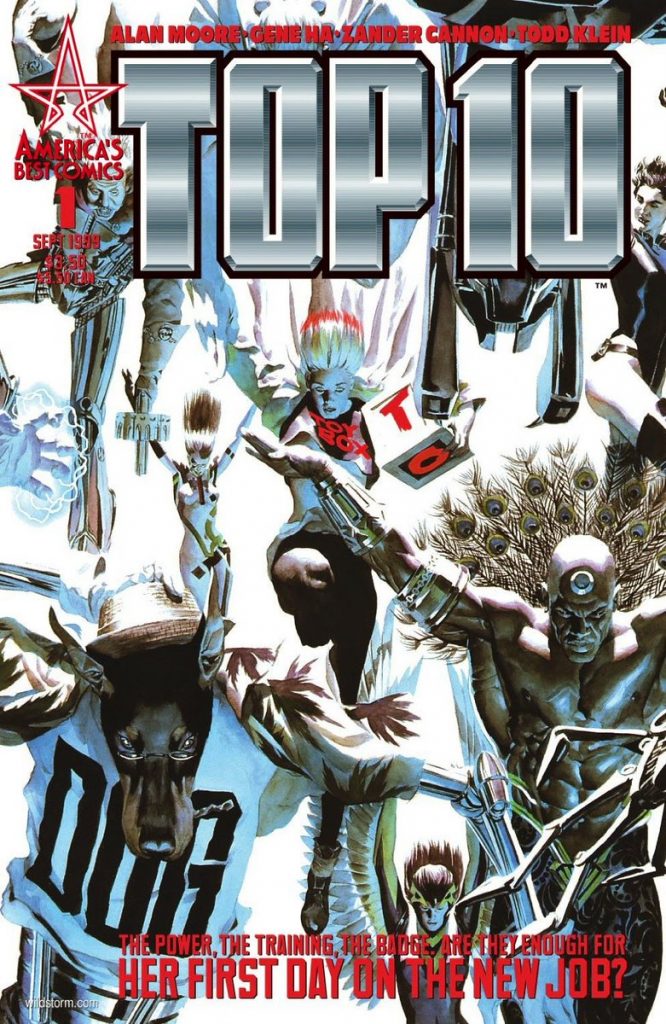
The good news is, Ha had plenty of prep time — maybe as much as a year, per the artist — which was necessary considering all the work the title asked of him. He made it halfway through the first issue before realizing the artist he wanted to collaborate with on the project initially wouldn’t be available. That was a problem. As Ha put it, he’s “not super-fast at anything in comics except faces.” With an extremely challenging project ahead, soloing it seemed as if it could be a painful experience.
That’s where Zander Cannon comes in.
The pair had met years before at a sparsely attended signing in a comic shop in Indiana, an event that gave the pair time to realize how much they enjoyed each other. They kept in touch, and a year or two later, Ha moved to Cannon’s home of Minneapolis. When the other artist fell through, Ha realized the “brilliant” Cannon would be a perfect partner on Top 10.
“So, I asked him to join me.”
How it played out means that Top 10 as a series has a couple before and after moments you can see within its pages. The first happens early on. If you ever felt like there was a change in how the series reads visually within the first issue, that’s because the initial 12 pages were drawn by Ha alone. The artist described those pages as “so relentlessly nonstop” compared to his work with Cannon. While the initial pages followed Moore’s scripts, Ha believes in retrospect that he “sometimes would jam too many things in at the wrong time,” causing it to not “flow well” from a storytelling standpoint.
And if there’s one thing Ha emphasized that he’s not fast at, it’s layouts. It was a bottleneck in the process. Thankfully, layouts were an area of strength for Cannon. The incoming artist was only in his late 20s and didn’t consider himself uniquely adept at anything at the time. But even if he was surprised by the offer and the belief Ha had in that specific skill of his, he wasn’t about to pass on the opportunity.
“I’m not the expert in anything, but if you are asking me if I want to work on this Alan Moore project, you are damn right I do,” Cannon remembered.
“Then we jumped into it.”
How They Worked Together
Much of the design work was complete before Cannon signed on, as Ha had to define the main cast before interiors could start. Cannon did have an impact there as well, though. Ha noted that his collaborator “designed a lot of the characters who didn’t show up in the original proposals,” like the two-faced 16 dispatcher Janus or the quintessential Cannon design for shark-headed lawyer Carl Fischman. Much of this happened quickly and even on the page, though, because the demands of the project were significant and fluid.
Their collaboration on the title was as well, and it wasn’t just the artists fine-tuning their approach throughout Top 10. Ha told me that “to some extent, Alan figured out what he wanted to do, too” as the series progressed. That’s where the other before and after comes in. Early on, everyone was still feeling each other out. That’s part of the reason Toybox — our point-of-view character in the first issue — suddenly looks like she was drawn by someone else entirely on page 13 of issue #1: she was! That was Cannon’s first page on the book, and an example of the artist providing finishes.
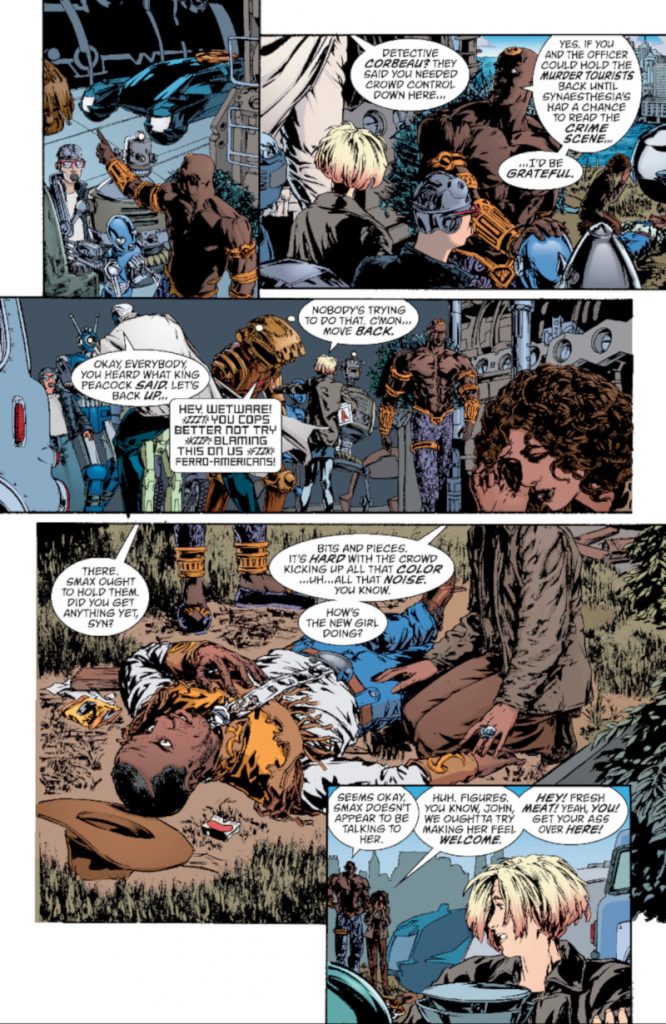
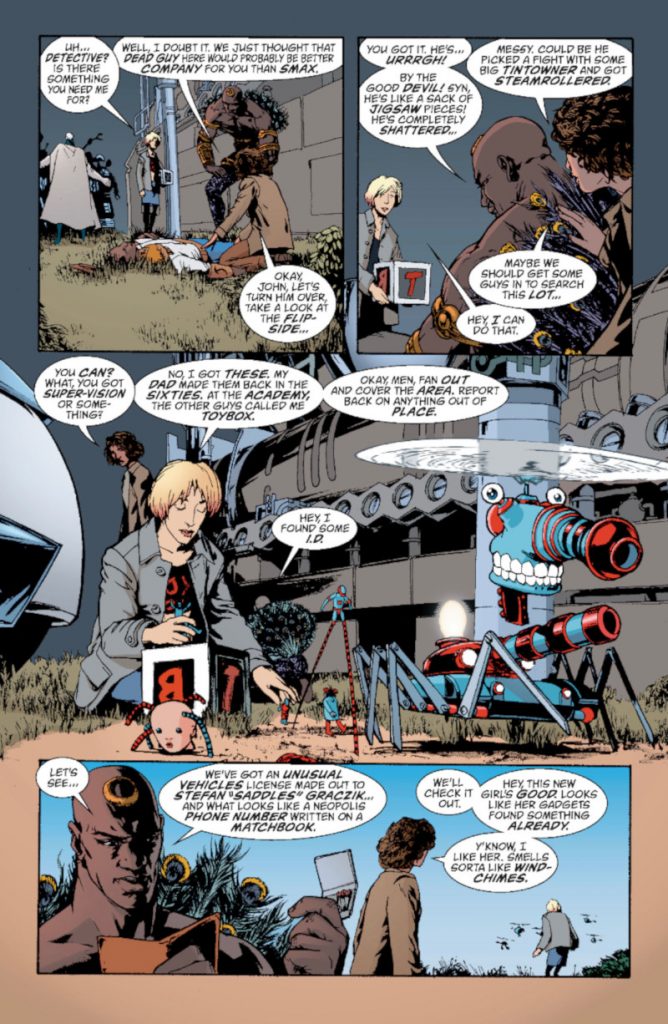
“If you look early on — in both issue #1 and #2 — you’ll see some scenes where it’s obvious Zander was doing finishes,” Ha told me. “It looks a little bit disjointed as far as style goes. We didn’t really have it down.”
You can see everyone getting more aligned in terms of processes as the book goes along. Part of that was just beginning to recognize each other’s strengths.
“By the end of the first issue and a little after the beginning of the second, it became totally clear to us that Zander’s insanely good and fast at layouts, storytelling, reading the script, interpreting it, and figuring out nuances I wouldn’t see,” Ha shared. “And for consistency of style, anatomy, perspective, backgrounds, and stuff like that, I can do things that Zander can’t do.”
It wasn’t just their talents deciding that, either. The pair quickly realized that their workflows existed in conflict. Cannon shared that they “had almost the complete opposite approach.” Certain steps in Ha’s process didn’t even exist in Cannon’s. Others were just in different places. That made the setup where he did layouts while Ha penciled and inked even more appealing.
Hashing all this out was made easier by the fact that they lived in the same city, with studios right next to each other. That allowed the pair to quickly discover the way to tackle Top 10 in the most complementary way possible. And the method they settled on was simple.
Cannon said his approach on Top 10 was “workmanlike,” focusing entirely on clarity of storytelling. He believed it was important to keep the layouts as traditional as possible, if only because the story itself was so fantastical it needed to be grounded in reality. While they didn’t earn an official credit for Cannon drawing layouts and Ha tackling pencils and inks until the sixth issue, Cannon estimates that they were fully locked in with that being the structure by the third issue. 17
Cannon said he would usually take a “pretty sloppy” run at the layouts on a piece of paper, then he would “put it on a light table and trace it” to effectively give Ha a character’s silhouette or even “two dots and a frowny face” to get his partner “going in the right direction.” His goal was to deliver something as “spare as possible” to allow for maximum flexibility. In short, Cannon gave Ha “pure composition and pure storytelling,” at which point Ha finished the pages, making the magic happen in the process.
“Once we settled into our working process, Gene’s brilliance is what’s on display,” Cannon emphasized.
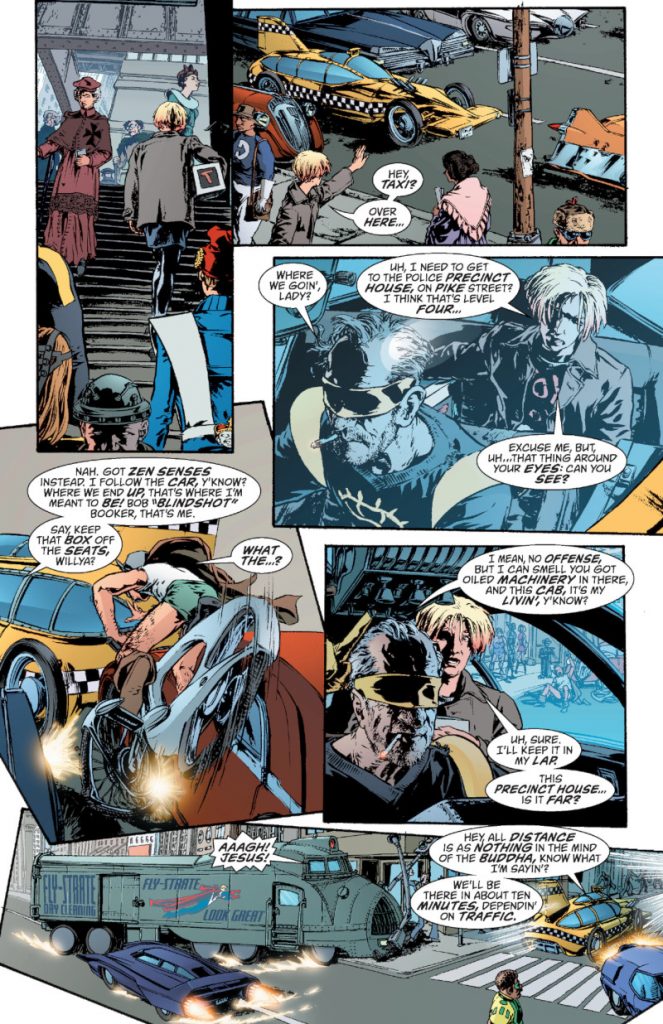
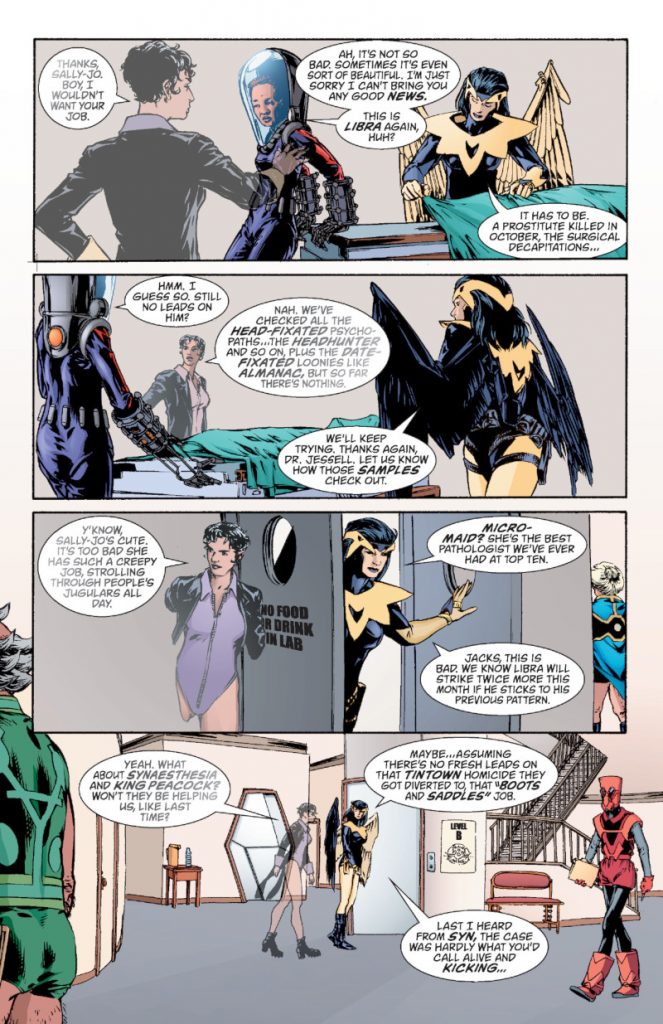
There was another important reason this process was necessary. Alan Moore’s scripts are famously dense — Cannon described his reaction to reading them by saying, “Jesus, this is covering literally all the bases” — and because of Ha’s admiration for the writer, he “was very reverential to the scripts.”
“If you can get a hold of an issue #1 script and then compare it to the first 12 pages of #1, I am following a recipe religiously like a chemistry student,” Ha told me.
That density can result in similarly dense storytelling. But while Ha stuck to the script, Cannon saw opportunity in the “basically unedited” single draft they would receive from the writer. And when I say, “single draft,” I mean there was for the most part only a first draft, per Cannon, which is why the bases being covered was so important. No one needed to ask “any clarifying questions,” Cannon told me. You just needed to read and interpret it, which he found freeing as someone fluent in the language of Alan Moore.
“Zander was the one who was able to tie it all together and essentially act as a translator between two of us in a way,” Ha told me. “Zander was able to figure out the storytelling build of Alan Moore, and then figure out a Zander Cannon way of telling the story more efficiently sometimes.”
“The nice thing about (Top 10) was it wasn’t this spare, tense drama. It was just a fire hose of junk out on the page,” Cannon added. “If you had to course correct a little bit to fix a problem or whatever, it was no big deal.
“It was part of the vibe.”
Ha mentioned that Cannon believed “Moore was reverse engineering” the script, down to the writer drawing “a thumbnail to all the layouts,” word balloons, figures, and all. That way when he sits down to write a script, “he’s literally describing his thumbnail.” The reason for that, Ha said, was how systematic the scripts were. It worked too well visually to not be the case, as it was “not something you can easily do when you’re just doing it from your imagination.” This made sense to Ha, if only because, as he put it, “Alan Moore is a comic book artist.”
subscribers only.
Learn more about what you get with a subscription
A former imprint of Wildstorm and then DC/Wildstorm.↩
To say nothing of its 2000 win for Best New Series.↩
To say nothing of the otherwise uninvolved franchise continuation in Paul Di Filippo and Jerry Ordway’s Top Ten: Beyond the Farthest Precinct.↩
Literally.↩
He noted that editorial was “reluctant” to even let them do that, and it was even difficult to invoice DC for the work he did at first. They eventually settled on each taking a percentage of the page rate for the art.↩
A former imprint of Wildstorm and then DC/Wildstorm.↩
To say nothing of its 2000 win for Best New Series.↩
To say nothing of the otherwise uninvolved franchise continuation in Paul Di Filippo and Jerry Ordway’s Top Ten: Beyond the Farthest Precinct.↩
Literally.↩
He noted that editorial was “reluctant” to even let them do that, and it was even difficult to invoice DC for the work he did at first. They eventually settled on each taking a percentage of the page rate for the art.↩
Or extremely large in the case of the drunk dad kaiju that is Gograh.↩
To say nothing of Hill Street Blues, a series from the 1980s that was an influence.↩
A former imprint of Wildstorm and then DC/Wildstorm.↩
To say nothing of its 2000 win for Best New Series.↩
To say nothing of the otherwise uninvolved franchise continuation in Paul Di Filippo and Jerry Ordway’s Top Ten: Beyond the Farthest Precinct.↩
Literally.↩
He noted that editorial was “reluctant” to even let them do that, and it was even difficult to invoice DC for the work he did at first. They eventually settled on each taking a percentage of the page rate for the art.↩
